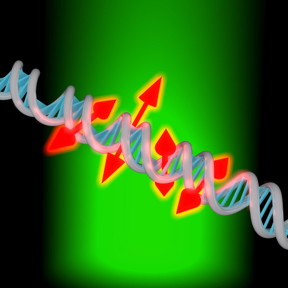New imaging method reveals nanoscale details about DNA: Enhancement to super-resolution microscopy shows orientation of individual molecules, providing a new window into DNA's structure and dynamics
Researchers have developed a new enhanced DNA imaging technique that can probe the structure of individual DNA strands at the nanoscale. Since DNA is at the root of many disease processes, the technique could help scientists gain important insights into what goes wrong when DNA becomes damaged or when other cellular processes affect gene expression.
The new imaging method builds on a technique called single-molecule microscopy by adding information about the orientation and movement of fluorescent dyes attached to the DNA strand.

A new imaging technique allows researchers to image both the position and orientation of single fluorescent molecules attached to DNA.
W. E. Moerner, Stanford University, USA, is the founder of single-molecule spectroscopy, a breakthrough method from 1989 that allowed scientists to visualize single molecules with optical microscopy for the first time. Of the 2014 Nobel Laureates for optical microscopy beyond the diffraction limit (Moerner, Hell & Betzig), Moerner and Betzig used single molecules to image a dense array of molecules at different times.
In The Optical Society's journal for high impact research, Optica, the research team led by Moerner describes their new technique and demonstrates it by obtaining super-resolution images and orientation measurements for thousands of single fluorescent dye molecules attached to DNA strands.
"You can think of these new measurements as providing little double-headed arrows that show the orientation of the molecules attached along the DNA strand," said Moerner. "This orientation information reports on the local structure of the DNA bases because they constrain the molecule. If we didn't have this orientation information the image would just be a spot."
Adding more nanoscale information
A strand of DNA is a very long, but narrow string, just a few nanometers across. Single-molecule microscopy, together with fluorescent dyes that attach to DNA, can be used to better visualize this tiny string. Until now, it was difficult to understand how those dyes were oriented and impossible to know if the fluorescent dye was attached to the DNA in a rigid or somewhat loose way.
Adam S. Backer, first author of the paper, developed a fairly simple way to obtain orientation and rotational dynamics from thousands of single molecules in parallel. "Our new imaging technique examines how each individual dye molecule labeling the DNA is aligned relative to the much larger structure of DNA," said Backer. "We are also measuring how wobbly each of these molecules is, which can tell us whether this molecule is stuck in one particular alignment or whether it flops around over the course of our measurement sequence."
The new technique offers more detailed information than today's so-called "ensemble" methods, which average the orientations for a group of molecules, and it is much faster than confocal microscopy techniques, which analyze one molecule at a time. The new method can even be used for molecules that are relatively dim.
Because the technique provides nanoscale information about the DNA itself, it could be useful for monitoring DNA conformation changes or damage to a particular region of the DNA, which would show up as changes in the orientation of dye molecules. It could also be used to monitor interactions between DNA and proteins, which drive many cellular processes.
30,000 single-molecule orientations
The researchers tested the enhanced DNA imaging technique by using it to analyze an intercalating dye; a type of fluorescent dye that slides into the areas between DNA bases. In a typical imaging experiment, they acquire up to 300,000 single molecule locations and 30,000 single-molecule orientation measurements in just over 13 minutes. The analysis showed that the individual dye molecules were oriented perpendicular to the DNA strand's axis and that while the molecules tended to orient in this perpendicular direction, they also moved around within a constrained cone.
The investigators next performed a similar analysis using a different type of fluorescent dye that consists of two parts: one part that attaches to the side of the DNA and a fluorescent part that is connected via a floppy tether. The enhanced DNA imaging technique detected this floppiness, showing that the method could be useful in helping scientists understand, on a molecule by molecule basis, whether different labels attach to DNA in a mobile or fixed way.
In the paper, the researchers demonstrated a spatial resolution of around 25 nanometers and single-molecule orientation measurements with an accuracy of around 5 degrees. They also measured the rotational dynamics, or floppiness, of single-molecules with an accuracy of about 20 degrees.
How it works
To acquire single-molecule orientation information, the researchers used a well-studied technique that adds an optical element called an electro-optic modulator to the single-molecule microscope. For each camera frame, this device changed the polarization of the laser light used to illuminate all the fluorescent dyes.
Since fluorescent dye molecules with orientations most closely aligned with the laser light's polarization will appear brightest, measuring the brightness of each molecule in each camera frame allowed the researchers to quantify orientation and rotational dynamics on a molecule-by-molecule basis. Molecules that switched between bright and dark in sequential frames were rigidly constrained at a particular orientation while those that appeared bright for sequential frames were not rigidly holding their orientation.
"If someone has a single-molecule microscope, they can perform our technique pretty easily by adding the electro-optic modulator," said Backer. "We've used fairly standard tools in a slightly different way and analyzed the data in a new way to gain additional biological and physical insight."
Source: Nanotechnology Now
- 351 reads
Human Rights
Ringing FOWPAL’s Peace Bell for the World:Nobel Peace Prize Laureates’ Visions and Actions

Protecting the World’s Cultural Diversity for a Sustainable Future

The Peace Bell Resonates at the 27th Eurasian Economic Summit

Declaration of World Day of the Power of Hope Endorsed by People in 158 Nations

Puppet Show I International Friendship Day 2020

